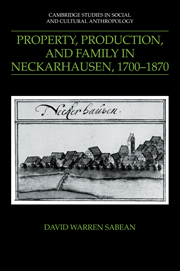Book contents
- Frontmatter
- Contents
- List of tables
- Abbreviations
- Abbreviations of sources
- Weights, measures, and coinage
- On reading kinship diagrams
- Glossary
- Preface
- Dedication
- Introduction
- 1 Productive forces and social differentiation
- 2 Magistrates and records
- 3 The ideology of the house
- 4 Patterns of marital conflict
- 5 The changing context of production
- 6 Marital relations in the context of production
- 7 Marital estate
- 8 State and estate
- 9 Marital fund
- 10 Generational transition
- 11 Reciprocities of labor and property
- 12 Reciprocities in parent–child relations
- 13 Authority, solidarity, and abuse
- 14 Family charges on the transfer of property
- 15 The real estate market
- 16 Kinship and the sale of property
- Conclusion
- Appendix
- Bibliography
- Index
- Cambridge studies in social and cultural anthropology
1 - Productive forces and social differentiation
Published online by Cambridge University Press: 09 February 2010
- Frontmatter
- Contents
- List of tables
- Abbreviations
- Abbreviations of sources
- Weights, measures, and coinage
- On reading kinship diagrams
- Glossary
- Preface
- Dedication
- Introduction
- 1 Productive forces and social differentiation
- 2 Magistrates and records
- 3 The ideology of the house
- 4 Patterns of marital conflict
- 5 The changing context of production
- 6 Marital relations in the context of production
- 7 Marital estate
- 8 State and estate
- 9 Marital fund
- 10 Generational transition
- 11 Reciprocities of labor and property
- 12 Reciprocities in parent–child relations
- 13 Authority, solidarity, and abuse
- 14 Family charges on the transfer of property
- 15 The real estate market
- 16 Kinship and the sale of property
- Conclusion
- Appendix
- Bibliography
- Index
- Cambridge studies in social and cultural anthropology
Summary
The Schultheiss and Börgermeister stick together because they are cousins, and the other magistrates support them, since they are all related to each other.
- The emigrant Jacob Hampf from Eglosheim, 1817The socioeconomic structures which developed in the half century after the Thirty Years War continued to characterize Württemberg until past the middle of the nineteenth century. Already in the eighteenth century, as Helga Schulz has ably shown, the density of handicrafts and trades in rural Württemberg was greater than in any East Elbian city. But occupational statistics have always been difficult to put together for Württemberg – and bedeviled investigators until as late as the 1880s – because artisans almost always combined their trade with land and agricultural production. From a census of 1857, Wolfgang von Hippel has established that 92 percent of the families of Württemberg held property of some kind. The transition between village and city was relatively fluid, and no great urban agglomerations developed by the end of our period. The capital city of the region (Oberamt) to which Neckarhausen belonged, for example, had a population only four times greater than the village as late as the mid-nineteenth century. It had well over three times as much arable and meadowland, and a considerable proportion of its inhabitants were occupied with agricultural production. Around 1700, agriculture was probably the primary source of income for more than 70 percent of the Württemberg population.
- Type
- Chapter
- Information
- Publisher: Cambridge University PressPrint publication year: 1991

